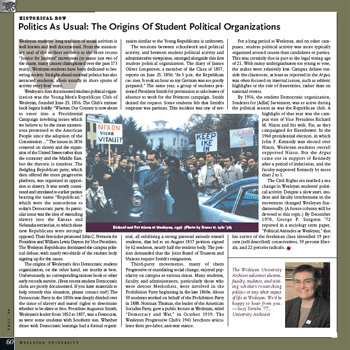HISTORICAL ROW: POLITICS AS USUAL: THE ORIGINS OF STUDENT POLITICAL ORGANIZATIONS
 Wesleyan students’ long tradition of social activism is well known and well documented. From the missionary zeal of the earliest students to the more recent “Justice for Janitors” movement (to name just two of the many, many causes championed over the past 173 years), Wesleyan students have been dedicated to bettering society. Straight-ahead national politics has also attracted students, albeit usually in short spurts of activity every four years.
Wesleyan students’ long tradition of social activism is well known and well documented. From the missionary zeal of the earliest students to the more recent “Justice for Janitors” movement (to name just two of the many, many causes championed over the past 173 years), Wesleyan students have been dedicated to bettering society. Straight-ahead national politics has also attracted students, albeit usually in short spurts of activity every four years.
Wesleyan’s first documented student political organization was the Young Men’s Republican Club of Wesleyan, founded June 25, 1856. The Club’s minute book begins boldly: “Whereas, Our Country is now about to enter into a Presidential Campaign involving issues which we believe to be the most momentous presented to the American People since the adoption of the Constitution …” The issues in 1856 centered on slavery and the expansion of the United States rather than the economy and the Middle East, but the rhetoric is timeless. The fledgling Republican party, which then offered the more progressive platform, was organized in opposition to slavery. It was newly constituted and unrelated to earlier parties bearing the name “Republican,” which were the antecedents to today’s Democratic party. At particular issue was the idea of extending slavery into the Kansas and Nebraska territories, to which these new Republicans were strongly opposed. Their first ticket promoted John C. Frémont for President and William Lewis Dayton for Vice President. The Wesleyan Republicans dominated the campus political debate, with nearly two-thirds of the student body signing up for the cause.
The origins of Wesleyan’s first Democratic student organization, on the other hand, are murky at best. Unfortunately, no corresponding minute book or other early records survive. (Even recent student Democratic clubs are poorly documented. If you have materials to help remedy this situation, please contact me!) The Democratic Party in the 1850s was deeply divided over the issue of slavery and states’ rights to determine whether to be slave or free. President Augustus Smith, Wesleyan’s leader from 1852 to 1857, was a Democrat, as were some students with Southern ties. Whether those with Democratic leanings had a formal organization similar to the Young Republicans is unknown.
The tensions between schoolwork and political activity, and between student political activity and administrative viewpoints, emerged alongside this first student political organization. The diary of James Oliver Longstreet, a member of the Class of 1857, reports on June 25, 1856: “At 5 p.m. the Republican cte. met. It took an hour so my German was too poorly prepared.” The same year, a group of students petitioned President Smith for permission to take leaves of absence to work for the Frémont campaign. Smith denied the request. Some students felt that Smith’s response was partisan. This incident was one of several, all exhibiting a strong parental attitude toward students, that led to an August 1857 petition signed by 62 students, nearly half the student body. The petition demanded that the Joint Board of Trustees and Visitors require Smith’s resignation.
Third-party movements, many of them Progressive or mandating social change, enjoyed popularity on campus at various times. Many students, faculty, and administrators, particularly those who were devout Methodists, were involved in the Prohibition Party beginning in the late 1860s. About 50 students worked on behalf of the Prohibition Party in 1888. Norman Thomas, the leader of the American Socialist Party, gave a public lecture at Wesleyan, titled “Democracy and War,” in October 1939. The Wesleyan Progressive Club’s 1941 brochure articulates their pro-labor, anti-war stance.
For a long period at Wesleyan, and on other campuses, student political activity was more typically organized around causes than candidates or parties. This was certainly due in part to the legal voting age of 21. With many undergraduates too young to vote, the stakes were relatively low. Campus debate outside the classroom, at least as reported in the Argus, was often focused on internal issues, such as athletic highlights or the role of fraternities, rather than on national events.
By 1956, the student Democratic organization, Students for [Adlai] Stevenson, was as active during the political season as was the Republican club. A highlight of that year was the campus visit of Vice President Richard M. Nixon and his wife, Pat, as they campaigned for Eisenhower. In the 1960 presidential election, in which John F. Kennedy was elected over Nixon, Wesleyan students overall supported Nixon. But the Argus came out in support of Kennedy after a period of indecision, and the faculty supported Kennedy by more than 2 to 1.
The Civil Rights era marked a sea change in Wesleyan students’ political activity. Despite a slow start, student and faculty involvement in the movement changed Wesleyan fundamentally. (A future column will be devoted to this topic.) By December 1970, George P. Surgeon ’72 reported in a sociology term paper, “Political Attitudes at Wesleyan,” that his survey of the freshman class identified 19 percent (self-described) conservatives, 59 percent liberals, and 22 percent radicals.
The Wesleyan University Archives welcomes alumni, faculty, students, and visiting scholars researching politics or any other aspect of life at Wesleyan. We’d be happy to hear from you.
—Suzy Taraba ’77, University Archivist
Download a PDF of the complete article HERE

